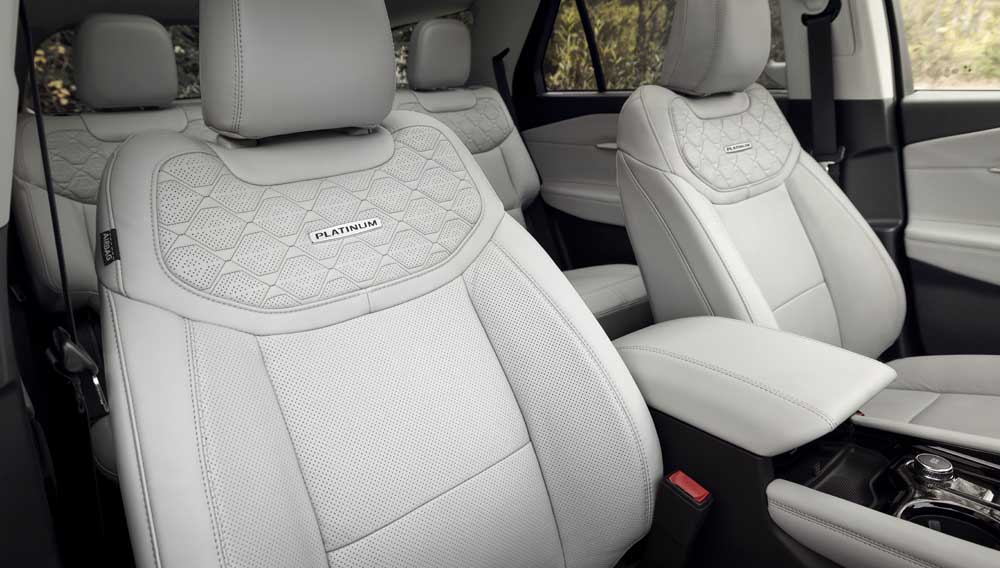The redesigned 2025 Ford Explorer is popular and influential
Published 9:00 am Monday, December 23, 2024

- The front bucket seats in the 2025 Ford Explorer are comfortable and supportive enough for long trips.
The 2025 Ford Explorer is not only a well-equipped, comfortable, and family-oriented SUV, it is also the current version of the best-selling SUV in America of all time, and a direct descendant of the SUV that first shifted the market away from cars in a big way.
Trending
I once read an article in an environmental publication that called the Ford Explorer the worst motor vehicle ever made. It claimed the first-generation Explorer released in 1990 made everyone want to buy gas-guzzling SUVs instead of more fuel-efficient cars. The argument was ridiculous for many reasons, beginning with the presumption of telling people what they shouldn’t buy with their own money to meet their family’s needs. Buyers have shifted from cars to EVs because of their obvious advantages, including better visibility, more interior room and cargo space, and the availability of all-wheel-drive for improved traction in slippery conditions.
But the writer got one thing right – the first Explorer helped increase the demand for SUVs. For starters, it was a compact, based on the Ford Ranger pickup. Most competitors were based on much larger full-size pickups. As a result, the Explorer was easier to drive downtown and in other crowded urban settings. But, when equipped with AWD, it was still good for outdoor recreational activities.
Early Explorers also came with a standard V6 engine that got better mileage than its larger competitors, most of which were equipped with thirstier V8 engines. In fact, the first Explorers got better mileage than some Ford cars back then, especially the full-size luxury models.
Trending
General Motors actually introduced a compact SUV five years earlier. The Chevy S10 Blazer was based on the compact S10 pickup. But it was only available as a two-door liftback. The Explorer debuted as a four-door liftback, which appealed more to families. Early reviews praised its car-like interior and ride, and noted that sales immediately exceeded expectations.
The current version of the Explorer is the sixth generation that was first introduced in 2020. Over the past three decades, it has undergone all of the changes that have shaped and reshaped the market. Like most SUVs today, the 2025 Explorer is no longer based on a truck but has its own unibody chassis, like a car. That greatly improves the ride and handling, and allows for even more fuel-efficient engines, including a base turbocharged 2.3-liter inline four in the current version that produces a respectable 300 horsepower and is EPA rated at 21 miles per gallon in the city and 28 on the highway. That’s better than the original 4.0-liter V6, which was EPA rated at 15/19.
The current Explorer is also much larger than the original, of course, reflecting the tendency of all motor vehicles to get larger over time. It is now a midsize with three rows of seats, which is the most competitive market segment these days. For those who want more power, the optional engine is a twin-turbocharged 3.0-liter V6 that produces a more impressive 400 horsepower. Although its EPA rating drops to 18/26, that’s still better than the original V6. Maximum towing capacity is 5,000 pounds.
Surprisingly, the optional engine in more powerful than the standard one in the Explorer Police Interceptor Utility that is only available to law enforcement agencies. It is powered by a normally-aspirated hybrid 3.3-liter V6 that produces 318 horsepower. The turbo 3.0 is offered as an option, however.
Ford has restyled the Explorer and changed the lineup for 2025. The exterior is bolder with a larger grill, while the interior now features a larger 12.3-inch center touchscreen. Trim levels have been reduced from eight to four with the elimination of the more off-road oriented Timberline and fancy King Ranch versions, among others.
My test 2025 Explorer was a Platinum version equipped with such options as the turbo 3.0, all-wheel-drive, and a luxurious leather interior. All of the upgrades pushed the price from $41,450 for the base rear-wheel-drive Active version to $59,865, which is very reasonable for an upper trim level midsize three-row crossover AWD SUV these days. Despite the Platinum name, the top-of-the-line version is actually the sporty-looking ST, which comes standard with the turbo 3.0, AWD, and special interior and exterior trim.
In a week of daily driving, I couldn’t immediately figure out why the Explorer has been so successful. The words that kept coming to mind were “competent,” “capable,” “solid.” It seemed to do everything fine but nothing exceptionally well. That’s different than many competitors that try to impress with some combination of exterior styling, interior design, showcased technologies, performance, and off-road capabilities. But I ended up figuring that Ford must know what buyers want because the Explorer was the 14th best-selling vehicle in America at the end of the third quarter of 2024, with 146,799 units sold. It was only (barely) trailing the newer version of the slightly newer Jeep Grand Cherokee in the midsize SUV class.
The Explorer has never been a style leader, and its redesigned exterior is largely generic, with the exception of the new larger grill covered in what Ford calls “unique satin” trim. The interior was roomy and comfortable, although the third row of seats is snug, like most midsize three-row SUVs. Although the larger display was easy to read and use, the surrounding dash was a mishmash of contrasting materials that included leather, cloth, wood, chrome and plastic that must have been designed by a committee.
On the road, the ride was firm without being harsh, but lacked the nimbleness of some competitors. That was notable because the optional turbo 3.0 V6 produces plenty of power. The throttle response is quicker when set in the Sport mode, but the firmer suspension felt unsettled around winding neighborhood roads, undercutting its day-to-day appeal. But most families aren’t looking for excitement going to and from work, ferrying children to school and activities, and running errands, after all.
The environmentally minded critic of the early Explorer also misjudged the automotive industry’s ability to adjust to consumer trends. The growing popularity of SUVs prompted Japanese manufacturers to respond just a few years later with even smaller and more fuel-efficient versions, most notably the first popular crossovers, the Honda Civic-based CR-V and the Toyota Corolla-based RAV4. Their success resulted in a wave of crossover SUVs that get much better mileage than any of the cars produced in 1990, including Ford’s own Escape, which continues today with conventional hybrid and plug-in hybrid versions.
So I would argue that in terms of innovation and customer choice, the Ford Explore is one of the best vehicles of all time. Buyers should be pleased that a recently restyled version is still on the market.
2025 Ford Explorer
Base price: $41,450 (Active RWD)
Price as tested: $59,865 (Platinum 4WD)
Type: Midsize three-row SUV
Engine: Turbocharged 2.3-liter 4 (300 hp, 310 lb-ft): twin-turbocharged 3.0-liter V6 (400 hp, 415 lb-ft – as tested)
Transmission: 10-speed automatic
Drive modes: Eco, Normal, Sport, Slippery, Off-Road, Tow/Haul
EPA estimated mileage: 18/25 (as tested)
Overall length: 198.7 inches
Curb weight: 4,788 pounds
Final assembly: Chicago, Illinois







